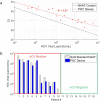Sample-to-Answer Droplet Magnetofluidic Platform for Point-of-Care Hepatitis C Viral Load Quantitation
- PMID: 29955160
- PMCID: PMC6023859
- DOI: 10.1038/s41598-018-28124-3
Sample-to-Answer Droplet Magnetofluidic Platform for Point-of-Care Hepatitis C Viral Load Quantitation
Abstract
Gold standard quantitative nucleic acid tests for diagnosis of viral diseases are currently limited to implementation in laboratories outside of the clinic. An instrument for conducting nucleic acid testing at the point-of-care (POC) that is easily operable by the clinician would reduce the required number of visits to the clinic and improve patient retention for proper treatment. Here we present a droplet magnetofluidic (DM) platform, which leverages functionalized magnetic particles to miniaturize and automate laboratory assays for use in the clinic at the POC. Our novel thermoformed disposable cartridge coupled to a portable multiaxial magnetofluidic instrument enables real-time PCR assays for quantitative and sensitive detection of nucleic acids from crude biosamples. Instead of laborious benchtop sample purification techniques followed by elution and spiking into PCR buffer, the user simply injects the biosample of interest into a cartridge with magnetic particles and loads the cartridge into the instrument. We demonstrate the utility of our platform with hepatitis C virus (HCV) RNA viral load quantitation from blood serum in approximately 1 hour. Clinical serum samples (n = 18) were directly processed on cartridges with no false positives and a limit of detection of 45 IU per 10 µl sample injection.
Conflict of interest statement
The authors declare no competing interests.
Figures






Similar articles
-
Sensitive and Quantitative Point-of-Care HIV Viral Load Quantification from Blood Using a Power-Free Plasma Separation and Portable Magnetofluidic Polymerase Chain Reaction Instrument.Anal Chem. 2023 Jan 17;95(2):1159-1168. doi: 10.1021/acs.analchem.2c03897. Epub 2022 Dec 23. Anal Chem. 2023. PMID: 36562405 Free PMC article.
-
Filtration-assisted magnetofluidic cartridge platform for HIV RNA detection from blood.Lab Chip. 2022 Mar 1;22(5):945-953. doi: 10.1039/d1lc00820j. Lab Chip. 2022. PMID: 35088790 Free PMC article.
-
Magnetic bead technology in viral RNA and DNA extraction from plasma minipools.Transfusion. 2005 Jul;45(7):1106-10. doi: 10.1111/j.1537-2995.2005.04356.x. Transfusion. 2005. PMID: 15987354
-
Ratiometric PCR in a Portable Sample-to-Result Device for Broad-Based Pathogen Identification.Anal Chem. 2022 Jul 5;94(26):9372-9379. doi: 10.1021/acs.analchem.2c01357. Epub 2022 Jun 21. Anal Chem. 2022. PMID: 35730588
-
Comparison of the Abbott Realtime HIV-1 and HCV viral load assays with commercial competitor assays.Expert Rev Mol Diagn. 2008 Jul;8(4):369-77. doi: 10.1586/14737159.8.4.369. Expert Rev Mol Diagn. 2008. PMID: 18598219 Review.
Cited by
-
Point-by-Point Progress: Gonorrhea Point of Care Tests.Expert Rev Mol Diagn. 2020 Aug;20(8):803-813. doi: 10.1080/14737159.2020.1778467. Epub 2020 Jun 30. Expert Rev Mol Diagn. 2020. PMID: 32500764 Free PMC article.
-
Sample-to-Answer Detection of SARS-CoV-2 Viremia Using Thermally Responsive Alkane Partitions.Anal Chem. 2024 Jul 23;96(29):12049-12056. doi: 10.1021/acs.analchem.4c02105. Epub 2024 Jul 8. Anal Chem. 2024. PMID: 38975928 Free PMC article.
-
Point-of-Care Platform for Rapid Multiplexed Detection of SARS-CoV-2 Variants and Respiratory Pathogens.Adv Mater Technol. 2022 Jun;7(6):2101013. doi: 10.1002/admt.202101013. Epub 2022 Jan 7. Adv Mater Technol. 2022. PMID: 35441089 Free PMC article.
-
A 3D-printed modular magnetic digital microfluidic architecture for on-demand bioanalysis.Microsyst Nanoeng. 2020 Jun 29;6:48. doi: 10.1038/s41378-020-0152-4. eCollection 2020. Microsyst Nanoeng. 2020. PMID: 34567660 Free PMC article.
-
Saliva-STAT: Sample-to-answer saliva test for COVID-19.Sens Actuators B Chem. 2024 Dec 15;421:136510. doi: 10.1016/j.snb.2024.136510. Epub 2024 Aug 23. Sens Actuators B Chem. 2024. PMID: 39282013
References
-
- IOM (Institute of Medicine). Hepatitis and Liver Cancer: A National Strategy for Prevention and Control of Hepatitis B and C, 10.17226/12793 (The National Academies Press, 2010). - PubMed
Publication types
MeSH terms
Grants and funding
LinkOut - more resources
Full Text Sources
Other Literature Sources
Medical

